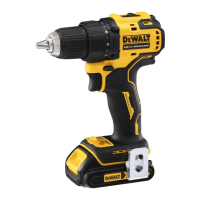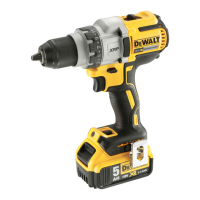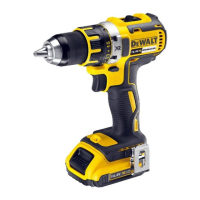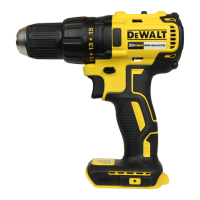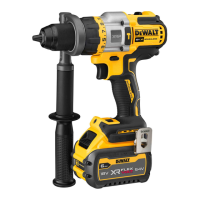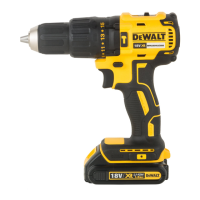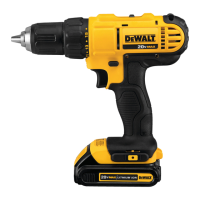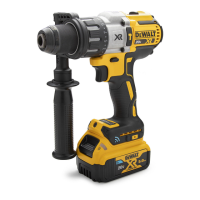36
ENGLISH
2. Select the desired speed/torque range using the
gear shifter
4
to match the speed and torque to the
plannedoperation.
3. For Wood, use twist bits, spade bits, power auger bits or
hole saws. For Metal, use high-speed steel twist drill bits
or hole saws. Use a cutting lubricant when drilling metals.
The exceptions are cast iron and brass which should be
drilleddry.
4. Always apply pressure in a straight line with the bit. Use
enough pressure to keep drill biting, but do not push hard
enough to stall the motor or deflect thebit.
5. Hold tool firmly with both hands to control the twisting
action of the drill. If model is not equipped with side handle,
grip drill with one hand on the handle and one hand on the
batterypack.
CAUTION: Drill may stall if overloaded causing a sudden
twist. Always expect the stall. Grip the drill firmly to control
the twisting action and avoidinjury.
6. IF DRILL STALLS, it is usually because it is being
overloaded or improperly used. RELEASE TRIGGER
IMMEDIATELY, remove drill bit from work, and determine
cause of stalling. DO NOT CLICK TRIGGER ON AND OFF
IN AN ATTEMPT TO START A STALLED DRILL THIS
CAN DAMAGE THEDRILL.
7. To minimise stalling or breaking through the material,
reduce pressure on drill and ease the bit through the last
fractional part of thehole.
8. Keep the motor running when pulling the bit back out of a
drilled hole. This will help preventjamming.
9. With variable speed drills there is no need to centre punch
the point to be drilled. Use a slow speed to start the hole
and accelerate by squeezing the trigger harder when the
hole is deep enough to drill without the bit skippingout.
Hammerdrill Operation (Fig.A,D)
1. Turn the collar
3
to the hammerdrillsymbol.
2. Select the high speed setting by sliding the gear shifter
4
back (away from thechuck).
IMPORTANT: Use carbide-tipped or masonry bitsonly.
3. Drill with just enough force on the hammer to keep it from
bouncing excessively or “rising” off the bit. Too much force
will cause slower drilling speeds, overheating and lower
drillingrate.
4. Drill straight, keeping the bit at a right angle to the work. Do
not exert side pressure on the bit when drillling as this will
cause clogging of the bit flutes and a slower drillingspeed.
5. When drilling deep holes, if the hammer speed starts to
drop off, pull the bit partially out of the hole with tool still
running to help clear debris from thehole.
NOTE: A smooth, even flow of dust from the hole indicates
proper drillingrate.
Proper Hand Position (Fig.D)
WARNING: To reduce the risk of serious personal injury,
ALWAYS use proper hand position asshown.
WARNING: To reduce the risk of serious personal
injury, ALWAYS hold securely in anticipation of a
suddenreaction.
Proper hand position requires one hand on the main handle
16
and one hand on the batterypack.
OPERATION
Instructions for Use
WARNING: Always observe the safety instructions and
applicableregulations.
WARNING: To reduce the risk of serious personal
injury, turn tool off and disconnect battery pack
before making any adjustments or removing/
installing attachments or accessories. An accidental
start-up can causeinjury.
Keyless Single Sleeve Chuck (Fig.C)
WARNING: Do not attempt to tighten drill bits (or
any other accessory) by gripping the front part of the
chuck and turning the tool on. Damage to the chuck
and personal injury may result. Always lock off trigger
switch and remove the battery from the tool when
changingacces sories.
WARNING: Always ensure the bit is secure before starting
the tool. A loose bit may eject from tool, causing possible
personalinjury.
Your tool features a keyless chuck
6
with one rotating chuck
sleeve
7
for one-handed operation of the chuck. To insert a drill
bit or other accessory, follow thesesteps.
1. Turn tool off and remove the batterypack.
2. Grasp the black sleeve of the chuck with one hand and
use the other hand to secure the tool. Rotate the sleeve
anticlockwise (as viewed from the front) far enough to
accept the desiredaccessory.
3. Insert the accessory about 19mm into the chuck and
tighten securely by rotating the chuck sleeve clockwise
with one hand while holding the tool with the other hand.
Continue to rotate the chuck sleeve until several ratchet
clicks are heard to ensure full grippingpower.
NOTE: Be sure to tighten chuck with one hand on
the chuck sleeve and one hand holding the tool for
maximumtightness.
To release the accessory, repeat steps 1and 2above.
Drill Operation (Fig.A,D)
WARNING: TO REDUCE THE RISK OF PERSONAL
INJURY, ALWAYS ensure workpiece is anchored or
clamped firmly. If drilling thin material, use a wood
“back-up” block to prevent damage to thematerial.
1. Turn the collar
3
to the drillsymbol.
